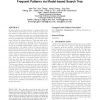Free Online Productivity Tools
i2Speak
i2Symbol
i2OCR
iTex2Img
iWeb2Print
iWeb2Shot
i2Type
iPdf2Split
iPdf2Merge
i2Bopomofo
i2Arabic
i2Style
i2Image
i2PDF
iLatex2Rtf
Sci2ools
KDD
2008
ACM
2008
ACM
Direct mining of discriminative and essential frequent patterns via model-based search tree
Frequent patterns provide solutions to datasets that do not have well-structured feature vectors. However, frequent pattern mining is non-trivial since the number of unique patterns is exponential but many are non-discriminative and correlated. Currently, frequent pattern mining is performed in two sequential steps: enumerating a set of frequent patterns, followed by feature selection. Although many methods have been proposed in the past few years on how to perform each separate step efficiently, there is still limited success in eventually finding highly compact and discriminative patterns. The culprit is due to the inherent nature of this widely adopted two-step approach. This paper discusses these problems and proposes a new and different method. It builds a decision tree that partitions the data onto different nodes. Then at each node, it directly discovers a discriminative pattern to further divide its examples into purer subsets. Since the number of examples towards leaf level i...
| Added | 30 Nov 2009 |
| Updated | 30 Nov 2009 |
| Type | Conference |
| Year | 2008 |
| Where | KDD |
| Authors | Wei Fan, Kun Zhang, Hong Cheng, Jing Gao, Xifeng Yan, Jiawei Han, Philip S. Yu, Olivier Verscheure |
Comments (0)

